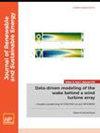风力发电厂尾流损失:涡轮机驱动与利用工程尾流模型控制电站尾流之间的脱节
IF 1.9
4区 工程技术
Q4 ENERGY & FUELS
引用次数: 0
摘要
随着在风力资源丰富的地区建造更多的风力发电厂,邻近发电厂的唤醒损失可能会成为风力发电厂设计和控制的主要因素。由于风力发电厂的风浪物理范围很大,从涡轮机转子直径到数十公里,因此尚不清楚传统的风浪模型或涡轮机控制策略在风力发电厂范围内是否有效。目前的研究对风浪转向和轴向感应控制进行了评估,以减少邻近风力发电厂对电力和平准化电力成本的影响。利用高斯-库尔混合唤醒模型和 TurbOPark 唤醒模型,以及两个运行和维护模型,对稳定状态下的唤醒转向和感应(FLORIS)进行了模拟,以研究控制设定点对唤醒表示和经济因素的敏感性。尽管唤醒损失的大小取决于唤醒模型,但两种唤醒模型都能估算出各种大气条件下的损失。年发电量和平准化电力成本受风向频率的影响,风向频繁的发电厂损失最大。然而,尾流转向和轴向感应都无法减轻上游电厂的影响。唤醒转向受到电厂几何形状的限制,因为唤醒位移远小于电厂唤醒宽度,而轴向诱导则需要削减上游电厂的大部分涡轮机。单个涡轮机策略受限于其有效规模和模型表示。需要建立包含电厂尺度物理特性的新型唤醒模型,以便设计有效的电厂唤醒控制策略。本文章由计算机程序翻译,如有差异,请以英文原文为准。
Wind plant wake losses: Disconnect between turbine actuation and control of plant wakes with engineering wake models
Wake losses from neighboring plants may become a major factor in wind plant design and control as additional plants are constructed in areas with high wind resource availability. Because plant wakes span a large range of physical scales, from turbine rotor diameter to tens of kilometers, it is unclear whether conventional wake models or turbine control strategies are effective at the plant scale. Wake steering and axial induction control are evaluated in the current work as means of reducing the impact of neighboring wind plants on power and levelized cost of electricity. FLOw Redirection and Induction in Steady State (FLORIS) simulations were performed with the Gauss–Curl Hybrid and TurbOPark wake models as well as two operation and maintenance models to investigate control setpoint sensitivity to wake representation and economic factors. Both wake models estimate losses across a range of atmospheric conditions, although the wake loss magnitude is dependent on the wake model. Annual energy production and levelized cost of electricity are driven by wind direction frequency, with frequently aligned plants experiencing the greatest losses. However, both wake steering and axial induction are unable to mitigate the impact of upstream plants. Wake steering is constrained by plant geometry, since wake displacement is much less than the plant wake width, while axial induction requires curtailing the majority of turbines in upstream plants. Individual turbine strategies are limited by their effective scale and model representation. New wake models that include plant-scale physics are needed to facilitate the design of effective plant wake control strategies.
求助全文
通过发布文献求助,成功后即可免费获取论文全文。
去求助
来源期刊

Journal of Renewable and Sustainable Energy
ENERGY & FUELS-ENERGY & FUELS
CiteScore
4.30
自引率
12.00%
发文量
122
审稿时长
4.2 months
期刊介绍:
The Journal of Renewable and Sustainable Energy (JRSE) is an interdisciplinary, peer-reviewed journal covering all areas of renewable and sustainable energy relevant to the physical science and engineering communities. The interdisciplinary approach of the publication ensures that the editors draw from researchers worldwide in a diverse range of fields.
Topics covered include:
Renewable energy economics and policy
Renewable energy resource assessment
Solar energy: photovoltaics, solar thermal energy, solar energy for fuels
Wind energy: wind farms, rotors and blades, on- and offshore wind conditions, aerodynamics, fluid dynamics
Bioenergy: biofuels, biomass conversion, artificial photosynthesis
Distributed energy generation: rooftop PV, distributed fuel cells, distributed wind, micro-hydrogen power generation
Power distribution & systems modeling: power electronics and controls, smart grid
Energy efficient buildings: smart windows, PV, wind, power management
Energy conversion: flexoelectric, piezoelectric, thermoelectric, other technologies
Energy storage: batteries, supercapacitors, hydrogen storage, other fuels
Fuel cells: proton exchange membrane cells, solid oxide cells, hybrid fuel cells, other
Marine and hydroelectric energy: dams, tides, waves, other
Transportation: alternative vehicle technologies, plug-in technologies, other
Geothermal energy
 求助内容:
求助内容: 应助结果提醒方式:
应助结果提醒方式:


